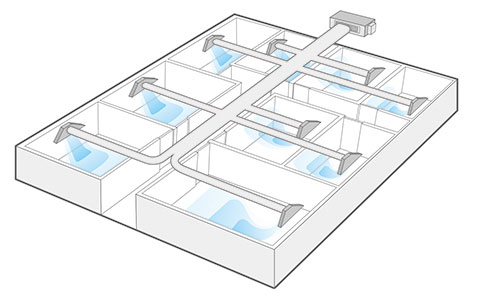
Ducted air conditioning systems are traditionally the most cost-effective way to provide distributed air conditioning throughout your home. A single indoor unit can supply conditioned air to multiple rooms, which reduces the cost.
Duct dampers optimise the airflow to each room. They are adjusted during installation to help balance the air flow to large and small rooms and also near and far rooms.
Duct dampers can be manually or electronically adjusted to optimise air flow for winter and summer. For example, in a two storey home you will want more cool air flow upstairs (which falls) and more warm air flow downstairs (which rises).
Duct Design
Duct design is very important ducted air conditioning systems to work properly. The duct size and length will vary from the main ducts to the branch ducts. This affects static pressure and hence air flow.
Ask whether an additional indoor unit makes sense for your house. This will reduce the static pressure from less air volume. It is possible to connect more than one indoor unit to a single outdoor unit.
Consider the ceiling space you have to run the ducts. You may need to add bulkheads to provide additional room for the ducts.
If you have a two storey house, it may make sense to install an indoor unit for each floor.
Finally, consider the air intake location. For reverse cycle air conditioning systems, they are being used for both heating and cooling. Therefore, if the air flow is ducted from the ceiling then the air intake needs to be at floor level. For a two storey house, it is most important to have the air intake at floor level on the ground floor.
Good duct design addresses static pressure, room zone control, rising warm air and falling cool air. The aim is to have even air flow to all rooms in all seasons.
Electronic Controls
Electronical controls can be added to ducted air conditioning systems for individual room zone control. A thermostat / controller can be mounted on the wall of each zoned room. Alternately, a central control system can be wall mounted in the main living room controlling all room zones from there.
Set up your electronic devices to operate or monitor your system remotely. This is another way to control individual room comfort or for your house as a whole.
Minimum Air Volume
When using electronic controls, you will be changing the air volume. Ducted air conditioning systems needs a minimum air volume to operate effectively. Close a duct damper and you will send more through the other ducts.
Ask your system designer what is specifically required for your house. In general, make the main kitchen / living areas the main conditioned zone along with all the open adjoining spaces such as hallways.
Air Diffusers
Choose from the many air diffusers available to suit the décor of your home. Air diffuser types range from traditional to sleek modern styles.
Other Air Conditioning Systems
Compare other whole of house air conditioning systems for cost and benefit. Consider how this affects your comfort, house design and budget.

VRF Systems
Consider VRF systems if you have a large house with cathedral ceilings or insufficient space to run ducting.
VRF systems allow many indoor units to be connected to a single outdoor unit and the system determines how much refrigerant to flow to each indoor unit for optimal performance. The system will take account of the distance from the outdoor unit.
Connect indoor units close or distant from the outdoor unit without balancing problems. The system will adjust the refrigerant flow automatically if you turn off indoor units connected to the system.
Split Systems
Consider Multi Split systems to add other non ducted indoor units including:
- In-ceiling cassettes, 1-way or 4-way types
- Low or high wall types
- Non ducted concealed indoor units in bulkheads
Consider Reverse Cycle Split systems for heating and cooling a single room or up to 3 rooms maximum. Above this, it is better go with Ducted, Multi Split or VRF systems.
Reverse Cycle Split systems usually have a single high wall indoor unit connected to a single outdoor unit. Therefore for 3 rooms, you would need 3 pairs of indoor and outdoor units installed, which starts to become cumbersome.
